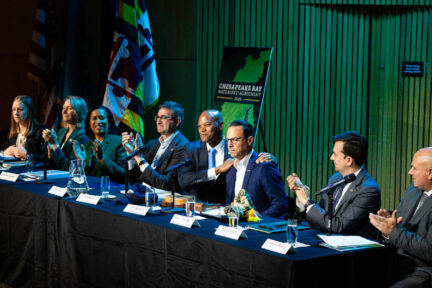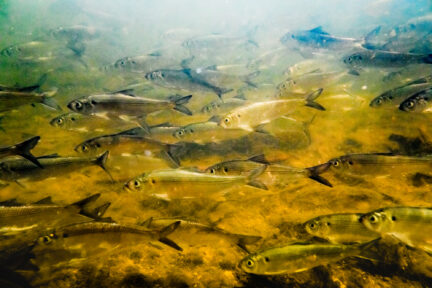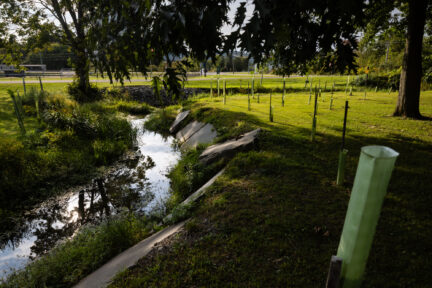Blue crabs doing better, but report notes there’s still room for improvement
A report encourages resource managers to maintain a “risk-averse” approach to setting regulations.
While blue crab numbers increased from last year, a report encourages resource managers to maintain a “risk-averse” approach to setting regulations in order to promote healthy numbers of the Chesapeake Bay’s blue crabs in the future.
The 2015 Chesapeake Bay Blue Crab Advisory Report was developed by the Chesapeake Bay Stock Assessment Committee (CBSAC), which includes scientists and representatives from federal and state governments and academic institutions. The report is based on data collected in the Bay-wide winter dredge survey (a cooperative effort of Maryland and Virginia) and on annual estimates of blue crab harvest; it indicates:
- Overall, blue crabs are doing fairly well. They are not overfished, and overfishing is not occurring.
- The number of female crabs increased in 2015, and the female population is no longer “depleted” as it was were in 2014. There were approximately 101 million female spawning-age crabs in the Chesapeake Bay at the start of the 2015 crabbing season. This is above the established threshold of 70 million, but not as many as the target of 215 million. (In 2014, the number of female crabs was 68.5 million—just below the threshold.)
- Currently, regulations aim to enable roughly 25%—but no more than 34%—of female blue crabs to be harvested each year. In 2014, only 17% of the female population was harvested.
- Numbers of juvenile crabs are up from last year, as well. It is estimated that there were 269 million juvenile crabs in the Bay at the start of 2015 crabbing season. Some of these crabs will mature to be adults, and would be big enough to be harvested in early fall and would also contribute to next year’s spawning stock.
- In 2014, the overall Bay-wide commercial harvest of blue crabs was 35 million pounds. This is down slightly from 37 million in 2013.
- Estimates of overwintering mortality of blue crabs in the Bay are some of the highest in recent history. More than 15% of blue crabs in the Bay are estimated to have died over the extremely cold 2014-15 winter.
“While the juvenile and female crab populations did increase from the previous year, the number of juveniles can vary greatly from year to year because of numerous variables in the environment,” said Joe Grist of the Virginia Marine Resources Commission, who also serves as chair of the Chesapeake Bay Stock Assessment Committee. “We encourage the jurisdictions that manage blue crabs in the Bay—Maryland, Virginia, and the Potomac River Fisheries Commission—to promote management plans that conserve the number of juvenile crabs that will be harvested during the current year’s fall fishery, and represent the spawning potential for 2016.”
The report also features short- and long-term management advice, including encouraging all three jurisdictions to continue their efforts to improve the quality of their catch and effort information submitted by both commercial and recreational crabbers. The CBSAC scientists also recommend that jurisdictions consider establishing a year-round sanctuary for mature females in the lower Bay and complementary sanctuaries or other management measures in the upper Bay that would promote survival of mature females. Also, the reports states that to sharpen accuracy of harvest data, improving estimates of recreational harvest of blue crabs must be made a priority.
“The annual Blue Crab Advisory Report is a great example of agencies and experts working together toward the goals of the Chesapeake Bay Watershed Agreement,” said Peyton Robertson, director of the NOAA Chesapeake Bay Office and chair of the Chesapeake Bay Program’s Sustainable Fisheries Goal Implementation Team, under which the Chesapeake Bay Stock Assessment Committee works. “CBSAC’s work directly supports our efforts to achieve the blue crab outcomes set forth in the Agreement, using the best science available to provide meaningful input to management decisions made by the jurisdictions.”
More information on Chesapeake Bay Program outcomes related to the blue crab fishery is available at www.chesapeakebay.net/chesapeakebaywatershedagreement/goal/sustainable_fisheries.
The advisory report was formally approved by Sustainable Fisheries Goal Implementation Team. The Team provides a forum to discuss fishery management issues that cross state and other jurisdictional boundaries and better connect sound science to management decision making.



